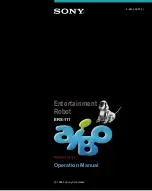
Programming manual for Meca500 (for firmware 9.2.x)
85
ETHERNET/IP COMMUNICATION
5. ETHERNET/IP COMMUNICATION
by ODVA, the Meca500 is compatible with the EtherNet/IP protocol. A common industry
standard, it can be used with many different PLC brands. Tested to work at 10 ms, faster times are also
possible. The Meca500 typically uses implicit (cyclic) messaging.
Refer to our
for specific PLC examples.
5.1. Connection types
When using EtherNet/IP, you can connect several Meca500 robots in the same way as with TCP/IP.
Either Ethernet port on the base of the robot can be used. Meca500 robots can be either daisy-chained
together or connected in a star pattern. The two ports on the Meca500 act as a switch in EtherNet/IP
mode.
5.2. EdS file
The Electronic Data Sheet (EDS) file for the Meca500 robot can be found in the zip file that contains your
robot's firmware update. These zip files are available in the
section of our web site.
5.3. forward open exclusivity
The Meca500 robot will allow only one controlling connection at the time (either a TCP/IP connection or
through an EtherNet/IP forward-open request).
If already being controlled, the robot will refuse a forward-open request with status error 0x106,
Ownership Conflict, in EtherNet/IP. It will refuse a TCP/IP connection with error [3001]. However, the web
interface can still be used in monitoring mode.
5.4. Enabling Ethernet/IP
To enable the EtherNet/IP communication protocol, you must connect to the robot via the TCP/
IP protocol first from an external client (e.g., from a PC using a Web browser), then send the
EnableEtherNetIP
(1) command. This is a persistent command, so it only needs to be set once. To
disable EtherNet/IP, you need to send the
EnableEtherNetIP
(0) command.
Note that EtherNet/IP can be left permanently enabled as it does not prevent using the TCP/IP protocol,
unlike EtherCAT and the
SwitchToEtherCAT
command.
5.5. Output tag assembly
The output tag assembly has an Instance of 150 with a size 60-byte array, as detailed below. Refer to
for a description of the different objects and their fields. The following subsections only define
how these objects are mapped to EtherNet/IP output tag assembly (as also described in the EDS file).
Summary of Contents for Meca500 R3
Page 10: ......















































